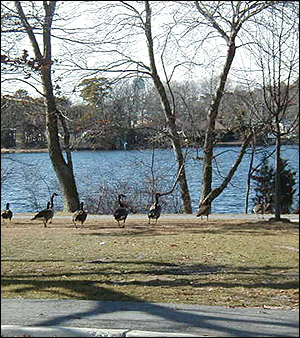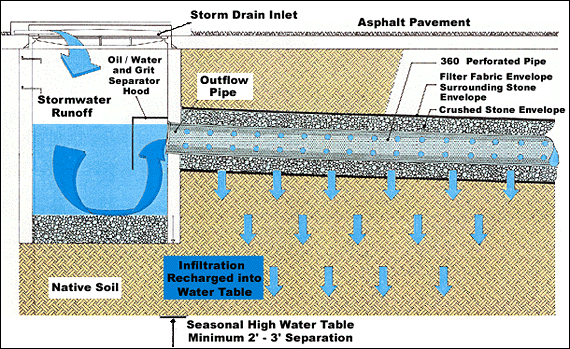![Stormwater Management - Background [Back]](../../../images/back.gif) |
Index | ![[Next]](../../../images/next-red.gif) |
 |
| View of Stafford City Center. Photo: John Spodofora, Councilman |
As a result of implementing standards and programs, Stafford Township has documented no deterioration in water quantity or quality over the past 15 years, and in many cases vast improvements to both surface and groundwater supplies.
Stafford Township has taken steps to protect lakes, streams, groundwater and bay through the implementation of a series of programs, standards and ordinances specifically addressing water quality, NPS pollution and groundwater recharge.
 |
| Stormwater management system, Stafford Township, New Jersey. Image: John Spodofora, Councilman |
In 1987, Stafford Township developed stormwater management ordinances that promote the underground recharge of stormwater, discourages the off-site discharge of post development runoff and uses oil and grit separators on all inlets. This design also encouraged the proper utilization of trees, buffers and landscaping as a natural filtration process.
Stafford Township made the determination to address stormwater management by attempting to use the natural processes in nature to control runoff and water quality. Maintaining groundwater levels by discouraging stormwater discharge of NPS pollution into waterways assures Stafford's rivers, lakes, streams and coastal waters will be fishable, swimmable and support healthy ecosystems.
|
The Stafford Township stormwater management design/process has been utilized in numerous municipalities throughout New Jersey and the Nation. Over the years, the design has been publicized in a number of magazines and publications. Stafford's process has also been recognized and published by numerous environmental groups and has received a number of National awards.
 |
| Construction of stormwater system, Stafford Township, N.J. Image: John Spodofora, Councilman |
Economic Benefits
The economic benefits associated with Stafford's stormwater management are numerous.
Stafford Township requires that each developer takes responsibility for the runoff they produce when developing a site. This reduces the amount of impervious surfaces and decreases the impact to the surrounding community and property owners.
Additionally, not allowing post-development runoff to leave the site assures no additional stresses or impact to existing municipal stormwater systems, bridges or culverts. By eliminating silt from entering Stafford's waterways, the Township has been able to avoid costly dredging projects.
The Federal Emergency Management Agency (FEMA) has recognized Stafford's stormwater management ordinance, open space preservation, watershed management and other programs as valid processes for controlling flooding. Because of these ordinances, and ongoing work with FEMA, the residents of Stafford were awarded a 10% discount in flood insurance premiums. Stafford has been notified that in the year 2000, we were given an additional 5% discount, for a total flood insurance premium discount of 15% for Stafford's residents.
|
In 1995, the National Geographic Society was researching stormwater, management and NPS pollution for an upcoming article. Stafford Townships approach was selected as the only innovative approach they were able to find which effectively managed stormwater. Mr. Peter Essick, the lead photographer for National Geographic, spent an entire week in Stafford documenting the town's process for the magazine. The program is also innovative in its use of landscaping on each site, specifying the species of plants and trees for their pollution removal capability, redesign of basins into shallow landscaped swales, larger islands in parking lots with shade trees to lessen the heat island effect, innovative oil and grit separators on each storm drain inlet, limiting impervious coverage, and a deeper open bottom sump on inlets. |
Additional information about Stafford Township can be found on their Web site (http://twp.stafford.nj.us/).
To read about Stafford Township's Stormwater Ordinance, click here (PDF format).
![Stormwater Management - Background [Back]](../../../images/back.gif) |
Index | ![[Next]](../../../images/next-red.gif) |
